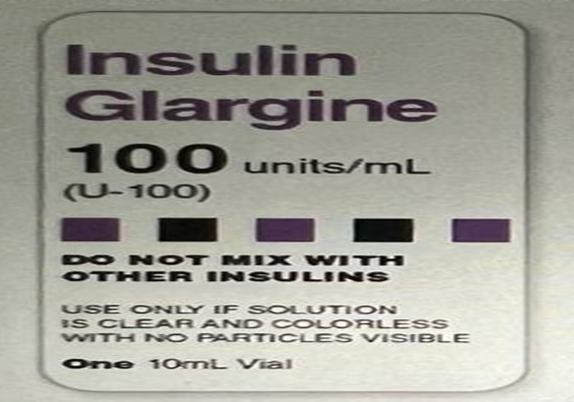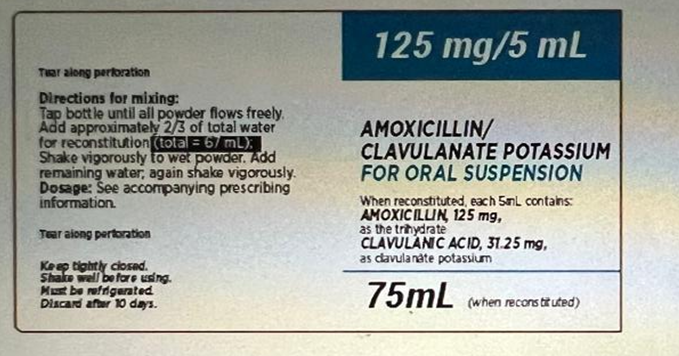Ati dosage calculation rn proctored assessment 3.2
Total Questions : 23
Showing 10 questions, Sign in for moreA nurse is preparing to administer insulin glargine to a child who has type 1 diabetes mellitus. The client is to receive 10 units subcutaneous once daily at bedtime. Reading the label on the unopened vial, the nurse should determine that the vial contains how many doses of this medication? (Round the answer to the nearest whole number. Use a leading zero if it applies. Do not use a trailing zero.)

Explanation
Calculation:
- Determine the total number of units in the vial.
The vial contains 10 mL of insulin glargine at a concentration of 100 units/mL.
Total units = Concentration x Volume
= 100 units/mL x 10 mL
= 1000 units.
- Calculate the number of doses in the vial.
The client's prescribed dose is 10 units per dose.
Number of doses = Total units in vial / Dose per administration
= 1000 units / 10 units/dose
= 100 doses.
A nurse is preparing to administer heparin 10,000 units subcutaneous every 8 hr. Available is heparin injection 20,000 units/mL. How many mL should the nurse administer per dose? (Round the answer to the nearest tenth. Use a leading zero if it applies. Do not use a trailing zero.)
Explanation
Desired dose = 10,000 units.
Available concentration = 20,000 units/mL.
Calculate the volume to administer in milliliters (mL).
Volume to administer (mL) = Desired dose (units) / Available concentration (units/mL)
= 10,000 units / 20,000 units/mL
= 0.5 mL.
A nurse is reinforcing teaching with a parent of an infant who has a prescription for amoxicillin 100 mg PO every 8 hr. Available is amoxicillin suspension 200 mg/5 mL. The nurse should tell the parent to administer how many tsp per dose? (Round the answer to the nearest tenth. Use a leading zero if it applies. Do not use a trailing zero.)
Explanation
Desired dose = 100 mg.
Available concentration = 200 mg/5 mL.
Find the concentration in mg per mL:
Concentration (mg/mL) = 200 mg / 5 mL
= 40 mg/mL.
- Calculate the volume to administer in milliliters (mL).
Volume (mL) = Desired dose (mg) / Concentration (mg/mL)
= 100 mg / 40 mg/mL
= 2.5 mL.
- Convert the volume from milliliters (mL) to teaspoons (tsp).
conversion factor: 1 tsp = 5 mL.
Volume (tsp) = Volume (mL) / 5 mL/tsp
= 2.5 mL / 5 mL/tsp
= 0.5 tsp.
A nurse is reviewing a new prescription for alendronate 70 mg PO once per week upon waking to be taken 30 min before food, fluids, or medication with a client who has osteoporosis. The client is to remain upright for 30 min after administration. How should the nurse interpret this prescription for the client?
A nurse is preparing to administer metronidazole 7.5 mg/kg PO to a client who weighs 146.7 lb. Available is metronidazole 500 mg tablets. How many tablets should the nurse administer? (Round the answer to the nearest whole number. Use a leading zero if it applies. Do not use a trailing zero.)
Explanation
- Convert the client's weight from pounds (lb) to kilograms (kg).
Client weight (kg) = 146.7 lb / 2.2 lb/kg
= 66.68 kg.
- Calculate the total dose in milligrams (mg).
Total dose (mg) = Client weight (kg) x Ordered dose (mg/kg)
= 66.68 kg x 7.5 mg/kg
= 500.1 mg.
- Calculate the number of tablets to administer.
Number of tablets = Total dose (mg) / Available strength (mg/tablet)
= 500.1 mg / 500 mg/tablet
= 1.0002 tablets.
- Round to the nearest whole number.
= 1 tablet.
A nurse is preparing to reconstitute amoxicillin/clavulanate oral suspension for a client. According to the medication label, what will the total volume of medication in the container be following reconstitution? (Round the answer to the nearest whole number. Use a leading zero if it applies. Do not use a trailing zero.)

Explanation
The medication label, under the drug name and concentration, specifies the final volume after reconstitution. The label clearly states 75 mL, which is the total volume of the suspension after the powder has been reconstituted with water.
A nurse is converting a medication dose from g to mcg. The amount available is 5 g. The nurse should recognize that this amount is equal to how many mcg? (Round the answer to the nearest whole number. Use a leading zero if it applies. Do not use a trailing zero.)
Explanation
Amount to be converted = 5 g.
- conversion factors.
1 g = 1,000 mg
1 mg = 1,000 mcg
Therefore, 1 g = 1,000,000 mcg.
- Convert grams (g) to micrograms (mcg).
Total mcg = Amount (g) x 1,000,000 mcg/g
= 5 g x 1,000,000 mcg/g
= 5,000,000 mcg.
A nurse is preparing to administer valproic acid 125 mg PO. Available is valproic acid syrup 250 mg/5 mL. How many mL should the nurse administer? (Round the answer to the nearest tenth. Use a leading zero if it applies. Do not use a trailing zero.)
Explanation
Desired dose = 125 mg.
Available concentration = 250 mg/5 mL.
Find the concentration in mg per mL:
Concentration (mg/mL) = 250 mg / 5 mL
= 50 mg/mL.
- Calculate the volume to administer in milliliters (mL).
Volume (mL) = Desired dose (mg) / Concentration (mg/mL)
= 125 mg / 50 mg/mL
= 2.5 mL.
A nurse is preparing to administer filgrastim 480 mcg subcutaneous daily. Available is filgrastim injection 300 mcg/mL. How many mL should the nurse administer per dose? (Round the answer to the nearest tenth. Use a leading zero if it applies. Do not use a trailing zero.)
Explanation
Desired dose = 480 mcg.
Available concentration = 300 mcg/mL.
- Calculate the volume to administer in milliliters (mL).
Volume to administer (mL) = Desired dose (mcg) / Available concentration (mcg/mL)
= 480 mcg / 300 mcg/mL
= 1.6 mL.
A nurse is teaching a newly hired nurse about documentation in the medical record. Which of the following abbreviations should the newly hired nurse identify as a metric unit of weight?
Sign Up or Login to view all the 23 Questions on this Exam
Join over 100,000+ nursing students using Naxlex’s science-backend flashcards, practice tests and expert solutions to improve their grades and reach their goals.
Sign Up Now


